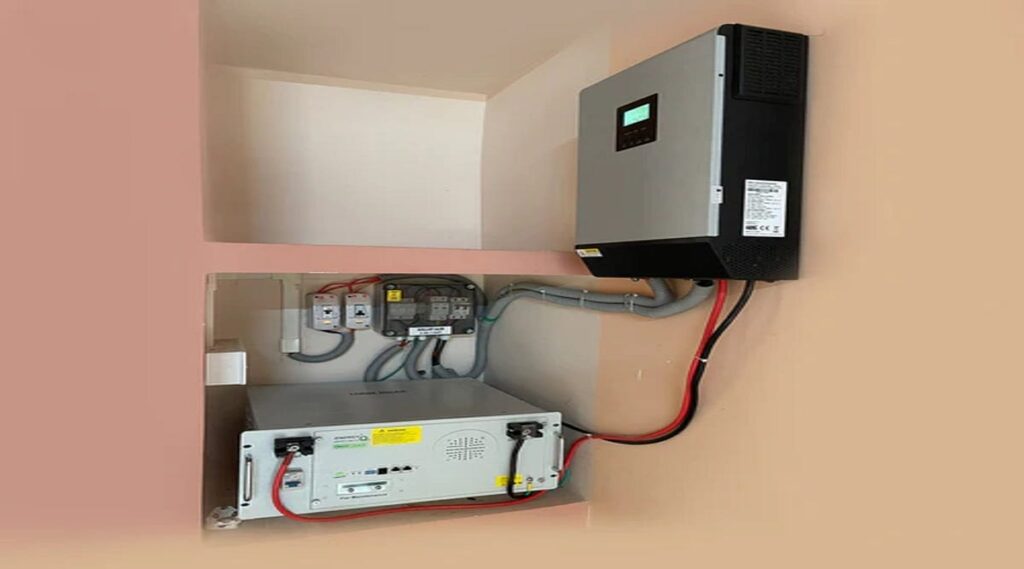Yes, connecting lithium batteries to inverters typically requires additional components and interfaces to ensure the system operates safely, efficiently, and reliably. These intermediary components help manage power flow, protect the system from potential issues, and optimize performance. Below are the key elements often involved in connecting lithium batteries to inverters:
1. Battery Management System (BMS)
A Battery Management System is essential for monitoring and managing the lithium battery’s performance. The BMS performs several critical functions:
- Voltage and Current Regulation: Ensures the battery operates within safe voltage and current limits.
- Temperature Monitoring: Prevents overheating by monitoring the battery’s temperature.
- State of Charge (SoC) and State of Health (SoH) Monitoring: Tracks the battery’s charge level and overall health.
- Protection Mechanisms: Guards against overcharging, over-discharging, and short circuits.
Importance: The BMS ensures the longevity and safety of the lithium battery, preventing damage and potential hazards.
2. Fuses and Circuit Breakers
Installing fuses or circuit breakers between the battery and inverter is crucial for system protection.
- Fuses: Provide overcurrent protection by breaking the circuit if current exceeds a specified limit.
- Circuit Breakers: Offer similar protection but can be reset after tripping, unlike fuses which need replacement.
Importance: These protective devices prevent damage to the inverter, battery, and other components in case of electrical faults.
3. Charge Controllers (Especially in Solar Systems)
In systems that incorporate solar panels, a charge controller regulates the power flowing from the panels to the battery.
- Function: Prevents overcharging by controlling the voltage and current coming from the solar panels.
- Types: PWM (Pulse Width Modulation) and MPPT (Maximum Power Point Tracking) controllers offer different levels of efficiency and control.
Importance: Ensures the battery is charged efficiently and safely, extending its lifespan and maintaining performance.
4. Communication Interfaces
Advanced systems often require communication between the inverter and the BMS for real-time monitoring and control.
- Protocols: Common communication protocols include CAN Bus, RS485, and Modbus.
- Data Exchange: Enables monitoring of battery status, temperature, voltage, and other critical parameters.
Importance: Facilitates intelligent energy management, enhancing system performance and reliability.
5. Cabling and Connectors
Proper cabling and connectors are vital for ensuring efficient and safe power transmission.
- Wire Gauge: Must be appropriately sized to handle the expected current load without significant voltage drops or overheating.
- Quality Connectors: Ensure secure and low-resistance connections to minimize energy loss and prevent faults.
Importance: Prevents energy loss, overheating, and potential electrical hazards, ensuring optimal system performance.
6. Isolation Devices
In some applications, isolation devices are necessary to separate different parts of the system electrically.
- Isolation Transformers: Provide electrical isolation between the battery and inverter, reducing the risk of electrical interference.
- Opto-Isolators: Used in signal lines to prevent ground loops and protect sensitive electronics.
Importance: Enhances system safety and reduces electrical noise, improving overall performance.
While it might be tempting to connect a lithium battery directly to an inverter, doing so without the necessary intermediary components can lead to inefficiencies, reduced battery life, and serious safety risks. Incorporating elements like a BMS, protective devices, proper cabling, and cooling systems ensures that the connection between lithium batteries and inverters is safe, efficient, and reliable. Always follow manufacturer guidelines and, if necessary, consult with a professional to design and install your energy storage system correctly.


